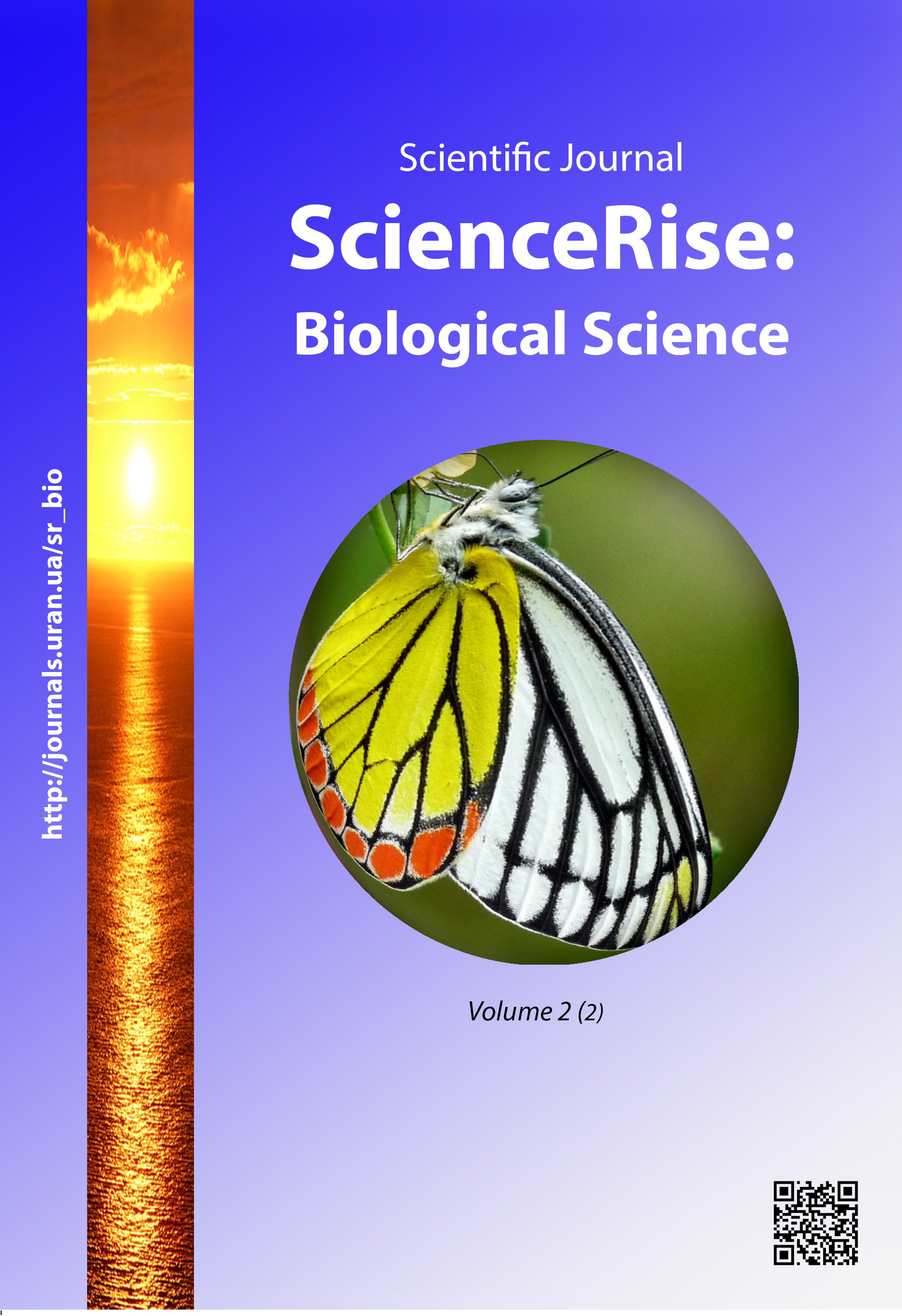Модель просторової структури білка AIMP1/р43 людини
DOI:
https://doi.org/10.15587/2519-8025.2016.81822Ключові слова:
AIMP1/р43, цитокіни, круговий дихроїзм (КД), комп’ютерне моделюванняАнотація
Проведено комп’ютерне моделювання повнорозмірної структури АІМР1/р43 – компонента аміноацил-тРНК-синтетазного комплексу вищих евкаріот. Побудована модель просторової структури димеру АІМР1/р43. Методом кругового дихроїзму отримано експериментальні дані про вміст елементів вторинної структури АІМР1/р43.Визначена просторова структура AIMP1/р43 відкриває можливість проводити структурно-функціональний аналіз взаємодії з іншими біологічно важливими молекулами
Посилання
- Wolfe, C. L., Warrington, J. A., Davis, S., Green, S., Norcum, M. T. (2009). Isolation and characterization of human nuclear and cytosolic multisynthetase complexes and the intracellular distribution of p43/EMAPII. Protein Science, 12 (10), 2282–2290. doi: 10.1110/ps.03147903
- Ivakhno, S. S., Kornelyuk, A. I. (2004). Cytokine-like activities of some aminoacyl-tRNAsynthetases and auxiliary p43 cofactor of aminoacylation reaction and their role in oncogenesis. Exp. Oncol., 26 (4), 250–255.
- Quevillon, S., Agou, F., Robinson, J.-C., Mirande, M. (1997). The p43 Component of the Mammalian Multi-synthetase Complex Is Likely To Be the Precursor of the Endothelial Monocyte-activating Polypeptide II Cytokine. Journal of Biological Chemistry, 272 (51), 32573–32579. doi: 10.1074/jbc.272.51.32573
- Shalak, V., Kaminska, M., Mitnacht-Kraus, R., Vandenabeele, P., Clauss, M., Mirande, M. (2001). The EMAPII Cytokine Is Released from the Mammalian Multisynthetase Complex after Cleavage of Its p43/proEMAPII Component. Journal of Biological Chemistry, 276 (26), 23769–23776. doi: 10.1074/jbc.m100489200
- Fu, Y., Kim, Y., Jin, K. S., Kim, H. S., Kim, J. H., Wang, D. et. al. (2014). Structure of the ArgRS–GlnRS–AIMP1 complex and its implications for mammalian translation. Proceedings of the National Academy of Sciences, 111 (42), 15084–15089. doi: 10.1073/pnas.1408836111
- Renault, L. (2001). Structure of the EMAPII domain of human aminoacyl-tRNA synthetase complex reveals evolutionary dimer mimicry. The EMBO Journal, 20 (3), 570–578. doi: 10.1093/emboj/20.3.570
- Larkin, M. A., Blackshields, G., Brown, N. P., Chenna, R., McGettigan, P. A., McWilliam, H. et. al. (2007). Clustal W and Clustal X version 2.0. Bioinformatics, 23(21), 2947–2948. doi: 10.1093/bioinformatics/btm404
- Ishida, T., Kinoshita, K. (2007). PrDOS: prediction of disordered protein regions from amino acid sequence. Nucleic Acids Research, 35 (Web Server), W460–W464. doi: 10.1093/nar/gkm363
- Dosztanyi, Z., Csizmok, V., Tompa, P., Simon, I. (2005). IUPred: web server for the prediction of intrinsically unstructured regions of proteins based on estimated energy content. Bioinformatics, 21 (16), 3433–3434. doi: 10.1093/bioinformatics/bti541
- Perez-Iratxeta, C., Andrade-Navarro, M. A. (2008). K2D2: Estimation of protein secondary structure from circular dichroism spectra. BMC Structural Biology, 8 (1), 25. doi: 10.1186/1472-6807-8-25
- Louis-Jeune, C., Andrade-Navarro, M. A., Perez-Iratxeta, C. (2011). Prediction of protein secondary structure from circular dichroism using theoretically derived spectra. Proteins: Structure, Function, and Bioinformatics, 80 (2), 374–381. doi: 10.1002/prot.23188
- Eswar, N., Webb, B., Marti-Renom, M. A., Madhusudhan, M. S., Eramian, D., Shen, M. et. al. (2007). Comparative Protein Structure Modeling Using MODELLER. Current Protocols in Protein Science, 2.9.1–2.9.31. doi: 10.1002/0471140864.ps0209s50
- Martí-Renom, M. A., Stuart, A. C., Fiser, A., Sánchez, R., Melo, F., Šali, A. (2000). Comparative Protein Structure Modeling of Genes and Genomes. Annual Review of Biophysics and Biomolecular Structure, 29 (1), 291–325. doi: 10.1146/annurev.biophys.29.1.291
- Xu, D., Zhang, Y. (2011). Improving the Physical Realism and Structural Accuracy of Protein Models by a Two-Step Atomic-Level Energy Minimization. Biophysical Journal, 101 (10), 2525–2534. doi: 10.1016/j.bpj.2011.10.024
- Chen, V. B., Arendall, W. B., Headd, J. J., Keedy, D. A., Immormino, R. M., Kapral, G. J. et. al. (2009). MolProbity: all-atom structure validation for macromolecular crystallography. Acta Crystallographica Section D Biological Crystallography, 66 (1), 12–21. doi: 10.1107/s0907444909042073
- Doreleijers, J. F., Sousa da Silva, A. W., Krieger, E., Nabuurs, S. B., Spronk, C. A. E. M., Stevens, T. J. et. al. (2012). CING: an integrated residue-based structure validation program suite. Journal of Biomolecular NMR, 54 (3), 267–283. doi: 10.1007/s10858-012-9669-7
- Schneidman-Duhovny, D., Inbar, Y., Nussinov, R., Wolfson, H. J. (2005). PatchDock and SymmDock: servers for rigid and symmetric docking. Nucleic Acids Research, 33 (Web Server), W363–W367. doi: 10.1093/nar/gki481
- Comeau, S. R., Gatchell, D. W., Vajda, S., Camacho, C. J. (2003). ClusPro: an automated docking and discrimination method for the prediction of protein complexes. Bioinformatics, 20 (1), 45–50. doi: 10.1093/bioinformatics/btg371
- Pettersen, E. F., Goddard, T. D., Huang, C. C., Couch, G. S., Greenblatt, D. M., Meng, E. C., Ferrin, T. E. (2004). UCSF Chimera?A visualization system for exploratory research and analysis. Journal of Computational Chemistry, 25 (13), 1605–1612. doi: 10.1002/jcc.20084
- Park, S. G., Choi, E. C., Kim, S. (2010). Aminoacyl-tRNASynthetase–Interacting Multifunctional Proteins (AIMPs): A Triad for Cellular Homeostasis. IUBMB Life, 62 (4), 296–302. doi: 10.1002/iub.324
##submission.downloads##
Опубліковано
Як цитувати
Номер
Розділ
Ліцензія
Авторське право (c) 2016 Дмитро Миколайович Ложко, Іванович Корнелюк Олександр

Ця робота ліцензується відповідно до Creative Commons Attribution 4.0 International License.
Наше видання використовує положення про авторські права Creative Commons CC BY для журналів відкритого доступу.
Автори, які публікуються у цьому журналі, погоджуються з наступними умовами:
1. Автори залишають за собою право на авторство своєї роботи та передають журналу право першої публікації цієї роботи на умовах ліцензії Creative Commons CC BY, котра дозволяє іншим особам вільно розповсюджувати опубліковану роботу з обов'язковим посиланням на авторів оригінальної роботи та першу публікацію роботи у цьому журналі.
2. Автори мають право укладати самостійні додаткові угоди щодо неексклюзивного розповсюдження роботи у тому вигляді, в якому вона була опублікована цим журналом (наприклад, розміщувати роботу в електронному сховищі установи або публікувати у складі монографії), за умови збереження посилання на першу публікацію роботи у цьому журналі.










